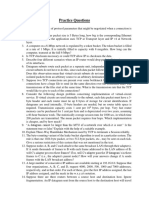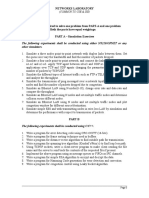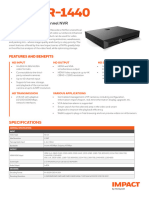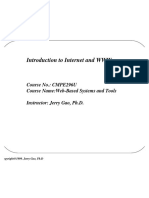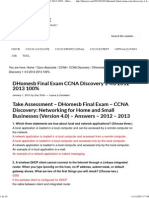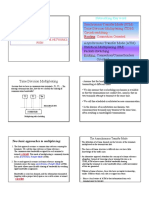CCN Assignment 2
CCN Assignment 2
Uploaded by
sundarCopyright:
Available Formats
CCN Assignment 2
CCN Assignment 2
Uploaded by
sundarCopyright
Available Formats
Share this document
Did you find this document useful?
Is this content inappropriate?
Copyright:
Available Formats
CCN Assignment 2
CCN Assignment 2
Uploaded by
sundarCopyright:
Available Formats
Review Questions
1. Suppose that the UDP receiver computes the Internet checksum for the received UDP
segment and finds that it matches the value carried in the checksum field. Can the receiver
be absolutely certain that no bit errors have occurred? Explain.
2. UDP and TCP use 1s complement for their checksums. Suppose you have the following
three 8-bit bytes: 01010011, 01100110, 01110100. What is the 1s complement of the sum
of these 8-bit bytes? (Note that although UDP and TCP use 16-bit words in computing the
checksum, for this problem you are being asked to consider 8-bit sums.) Show all work.
Why is it that UDP takes the 1s complement of the sum; that is, why not just use the sum?
With the 1s complement scheme, how does the receiver detect errors? Is it possible that a
1-bit error will go undetected?
3. Draw the FSM for the receiver side of protocol rdt3.0.
4. Differentiate between UDP and TCP protocols.
5. Explain the multiplexing and demulitplexing techniques. With a neat diagram of the
TCP/UDP segment formats explain a scenario and elaborate with respect to the changes in
the address fields during the multiplexing and demultiplexing process.
6. With an example of a network scenario explain the Connection oriented demux technique.
7. With the help of a flow chart and state diagram, explain the principles of reliable data
transfer.
8. Describe the operation of rdt2.0 considering the scenarios with errors and with no errors.
9. With a FSM explain how the sender, handles garbled ACK/NAKs with respect to rdt2.1
10. List the examples of pipelined protocols. Differentiate between their operations (Go-Back-
N and Selective repeat)with an example scenario.
11. Explain the TCP retransmission for lost ACK scenario and for scenario with premature
timeout.
12. With the help of a FSM explain the TCP 3-way handshake.
13. Identify the two important network-layer functions. Explain the functioning of a routing
protocol with the help of a self defined network scenario and demonstrate the formation of
forwarding tables.
14. What are the three identifiable phases in a virtual circuit.Explain how the network layer
helps in the process of VC maintainance.
15. Discuss the architecture of a generic router. Highlight on decentralizing switching
technique.
16. Compare and contrast link-state and distance-vector routing algorithms.
17. Compare and contrast the advertisements used by RIP and OSPF.
18. What is meant by subnetting. Explain why a subnet mask is used.
19. Explain the IPv4 datagram format. Highlight on IP fragmentation and reassembly.
20. For the IP 192.168.1.0, Give the total no. of subnets, blocksize, first host and last host of
each subnet for a CIDR value of 28.
21. Write a short notes on DHCP.
22. Explain the concepts CSMA with different persistent a) p-persistent b) Non-persistent c)
1-persistent.
You might also like
- Midterm2 cp372 SolutionDocument8 pagesMidterm2 cp372 SolutionbottbottNo ratings yet
- Lesson 2Document3 pagesLesson 2Jacob SwainNo ratings yet
- Ipv6 Tutorial PDFDocument32 pagesIpv6 Tutorial PDFVijay ShuklaNo ratings yet
- 08.703 Computer Networks Question Bank: Ans: PPP Data FrameDocument7 pages08.703 Computer Networks Question Bank: Ans: PPP Data Framesendtomerlin4uNo ratings yet
- Data Communication Network QBDocument4 pagesData Communication Network QBPratiksha HoleyNo ratings yet
- Assignment 1Document4 pagesAssignment 1akttripathiNo ratings yet
- Unit 3 and 4 QuestionsDocument4 pagesUnit 3 and 4 QuestionsNithyasri ANo ratings yet
- 8EC1 Computer NetworksDocument7 pages8EC1 Computer NetworksDashrath InkhiaNo ratings yet
- CNS QB Cie-2 2022Document1 pageCNS QB Cie-2 2022Adithi HebbalNo ratings yet
- CN Question Bank (Autorecovered)Document4 pagesCN Question Bank (Autorecovered)GAURAV SHETNo ratings yet
- ELEN 4017 - Network Fundamentals Tutorial No. 3: InstructionsDocument3 pagesELEN 4017 - Network Fundamentals Tutorial No. 3: Instructionsasadmehmud5934No ratings yet
- Question Bank Pre-GTU Computer Network Computer Engineering DepartmentDocument3 pagesQuestion Bank Pre-GTU Computer Network Computer Engineering DepartmentgobinathNo ratings yet
- Computer Networks - Assignment: CB84000D001C001CDocument1 pageComputer Networks - Assignment: CB84000D001C001CGirmit GirmitNo ratings yet
- ACN - Full QBDocument5 pagesACN - Full QBshabacutipieNo ratings yet
- Assignm End Sem NetworkingDocument3 pagesAssignm End Sem NetworkinganukalpkumarthakurNo ratings yet
- CN Question BankDocument4 pagesCN Question BankSeemon BhadoriaNo ratings yet
- Question Bank CNDocument4 pagesQuestion Bank CNyashhardasaniNo ratings yet
- Question BankDocument7 pagesQuestion Bankkaleemalam54No ratings yet
- Questions TCPDocument2 pagesQuestions TCPARUOS SouraNo ratings yet
- Computer Network and Security, All The Module Question Bank VtuDocument3 pagesComputer Network and Security, All The Module Question Bank VtubibliophileonthesamepageNo ratings yet
- Module-2 (Half Portion)Document2 pagesModule-2 (Half Portion)prakashanand8848No ratings yet
- 18it502 - DCCN - Question Bank-1Document6 pages18it502 - DCCN - Question Bank-1SHANMUGAM SNo ratings yet
- S.R.M. Institute of Science & Technology Department of Computer Science and EngineeringDocument7 pagesS.R.M. Institute of Science & Technology Department of Computer Science and Engineeringਹਰਪਿ੍ਤ ਸਿੰਘNo ratings yet
- CN Question BankDocument3 pagesCN Question Bank22r11a05t5No ratings yet
- ACN MSBTE CAMPUS Questions BankDocument4 pagesACN MSBTE CAMPUS Questions Bankkamransyed8519No ratings yet
- QB - Computer NetworksDocument2 pagesQB - Computer Networksvaibhav ghanekarNo ratings yet
- QBDocument2 pagesQBsandeep rangariNo ratings yet
- Practice Questions For MCADocument4 pagesPractice Questions For MCAmanisha bhandariNo ratings yet
- Transport LayerDocument32 pagesTransport LayerRaghunath2uNo ratings yet
- Practice Set - CNDocument6 pagesPractice Set - CNtheindianhornNo ratings yet
- CN Question BankDocument5 pagesCN Question BankPavan Kumar0% (1)
- CCN qb3Document2 pagesCCN qb3Savitri KanshetteNo ratings yet
- CN Question Bank Module 1 2Document2 pagesCN Question Bank Module 1 2Sushmitha ChikkamaduNo ratings yet
- CS 349 - Assignmet 3 QuestionsDocument5 pagesCS 349 - Assignmet 3 QuestionsHarsh RajNo ratings yet
- Computer Networks Question BankDocument2 pagesComputer Networks Question Bankcapitalclangames02No ratings yet
- Advanced Computer Network IMP QB By MSBTE CAMPUS ACADEMYDocument5 pagesAdvanced Computer Network IMP QB By MSBTE CAMPUS ACADEMYyashdhawale24No ratings yet
- Part BDocument4 pagesPart BBharathwaj SKNo ratings yet
- CN Lab ProgramsDocument36 pagesCN Lab ProgramsKavitha SANo ratings yet
- Dc792tutorial AssinmentDocument5 pagesDc792tutorial AssinmentKanu GuptaNo ratings yet
- SCTP vs. TCP - Comparing Packets Loss Rate of Transport Protocols in Best-Effort NetworksDocument8 pagesSCTP vs. TCP - Comparing Packets Loss Rate of Transport Protocols in Best-Effort NetworksMahmoud DoughanNo ratings yet
- Sem-4 DCC 6 Marks IMPsDocument2 pagesSem-4 DCC 6 Marks IMPssaqibzuber813No ratings yet
- DSS Question BankDocument3 pagesDSS Question BanksaralabitmNo ratings yet
- Network Routing and SwitchingDocument3 pagesNetwork Routing and SwitchingKawsar AliNo ratings yet
- Datalink AnswersDocument3 pagesDatalink AnswersNguyễn Văn HiếnNo ratings yet
- CN QuesstionsDocument13 pagesCN QuesstionsMadhavarapu SuchendraNo ratings yet
- CS6551 Computer NetworksDocument7 pagesCS6551 Computer NetworksMogili sivaNo ratings yet
- Transport LayerDocument31 pagesTransport LayerNishanth KalakuntlaNo ratings yet
- ENSC427 Final 1231Document4 pagesENSC427 Final 1231477889997mNo ratings yet
- CN Question BankDocument3 pagesCN Question BankDeeksha AdhvikNo ratings yet
- CN Practice Questions (All Modules)Document7 pagesCN Practice Questions (All Modules)anjul tiwariNo ratings yet
- Datocom AnswersDocument11 pagesDatocom AnswersHalefom DestaNo ratings yet
- Possible Question Summary From Previous Year QuestionDocument12 pagesPossible Question Summary From Previous Year QuestionRISHI NITHIN.E.MNo ratings yet
- Assigment CNDocument5 pagesAssigment CNpachauribarunNo ratings yet
- DCCN Model Question-TheoryDocument13 pagesDCCN Model Question-TheoryChirag ParasharNo ratings yet
- 10M CN Question BankDocument2 pages10M CN Question Bankvsureshkumar1116No ratings yet
- Unit 3, 4, 5 - Transport Layer, Network Layer, Datalink LayerDocument2 pagesUnit 3, 4, 5 - Transport Layer, Network Layer, Datalink LayerNirmalNo ratings yet
- UNIT-III TransportLayerDocument30 pagesUNIT-III TransportLayeruknown6600No ratings yet
- Computer Networks QB 2023Document6 pagesComputer Networks QB 2023trapti191967No ratings yet
- @vtucode - in - CN QUESTION BANK 2021 SCHEMEDocument7 pages@vtucode - in - CN QUESTION BANK 2021 SCHEMEvinaykumarms343No ratings yet
- CN QuestionsDocument5 pagesCN Questions21131a03a5No ratings yet
- Fastiron 08070 DhcpguideDocument103 pagesFastiron 08070 DhcpguideSuresh VNNo ratings yet
- in 0000 Sa 00001Document1 pagein 0000 Sa 00001Ananthan SrijithNo ratings yet
- Advanced Troubleshooting CCIE Routing & Switching v5.0Document24 pagesAdvanced Troubleshooting CCIE Routing & Switching v5.0Thomas PSNo ratings yet
- 1017-09-018, Rev. 0 - miniiSED Communication ProtocolDocument16 pages1017-09-018, Rev. 0 - miniiSED Communication ProtocolRuny RunyNo ratings yet
- I-Hnvr-1440 Datasheet V2Document2 pagesI-Hnvr-1440 Datasheet V2dhavalheaven2023No ratings yet
- Pentesting Wifi - HackTricks - HackTricksDocument31 pagesPentesting Wifi - HackTricks - HackTricksvm.dixon1No ratings yet
- Finals Activity 1 - 6.4.3.3 Packet Tracer - Connect A Router To A LANDocument5 pagesFinals Activity 1 - 6.4.3.3 Packet Tracer - Connect A Router To A LANjaxmain1750No ratings yet
- Networks-Lab 6632853 PowerpointDocument22 pagesNetworks-Lab 6632853 PowerpointVivek Kumar SinhaNo ratings yet
- Introduction To Internet PDFDocument27 pagesIntroduction To Internet PDFbalajiNo ratings yet
- About Airodump-Ng - JavatpointDocument3 pagesAbout Airodump-Ng - JavatpointNITISHNo ratings yet
- Ipm Lab Instructions V5dot1Document24 pagesIpm Lab Instructions V5dot1SparkLeeNo ratings yet
- Assignment 3 SolutionDocument3 pagesAssignment 3 SolutionDeeni BaateinNo ratings yet
- LAN DesignDocument54 pagesLAN DesignRashed Al-GhwieenNo ratings yet
- Control FlowDocument14 pagesControl FlowGunz Teritory Omz100% (1)
- IPRAN ATN+CX (HVPN) Solution Poster 03Document1 pageIPRAN ATN+CX (HVPN) Solution Poster 03ElfatihHashim12No ratings yet
- Access NetworkDocument135 pagesAccess NetworkBilal HassanNo ratings yet
- Telecom Assignment 2Document4 pagesTelecom Assignment 2Emmanuel BongayNo ratings yet
- IOT Unit 1Document8 pagesIOT Unit 1LAUGHTER CLUBNo ratings yet
- DHCP ConfDocument30 pagesDHCP ConfMaheshwar BolewarNo ratings yet
- Itt320 Quiz (Question)Document9 pagesItt320 Quiz (Question)tesqNo ratings yet
- (OptiX OSN 8800) RMON - ALM - INBADOCTS - OVER Alarm in A TOA BoardDocument6 pages(OptiX OSN 8800) RMON - ALM - INBADOCTS - OVER Alarm in A TOA BoardSery ArthurNo ratings yet
- Docu71061 XtremIO XIOS 4.0.2 and 4.0.4 and 4.0.10 and 4.0.15 With XMS 4.2.0 and 4.2.1 Storage Array Security Configuration GuideDocument10 pagesDocu71061 XtremIO XIOS 4.0.2 and 4.0.4 and 4.0.10 and 4.0.15 With XMS 4.2.0 and 4.2.1 Storage Array Security Configuration GuideGGNo ratings yet
- 2020-Problem Set 1Document5 pages2020-Problem Set 1chinnianu668No ratings yet
- CNE Tutorial 07 - Dynamic Routing Configuration With RIPDocument11 pagesCNE Tutorial 07 - Dynamic Routing Configuration With RIPThơm VũNo ratings yet
- Air Ap2802i e k9 DatasheetDocument4 pagesAir Ap2802i e k9 DatasheetDarwin.pilloNo ratings yet
- Lab 7Document6 pagesLab 7Khadija KhanNo ratings yet
- 1.3-Basic Packet Analysis WiresharkDocument24 pages1.3-Basic Packet Analysis WiresharknbadungNo ratings yet
- Heiser Dev Zone: Dhomesb Final Exam Ccna Discovery 1 4.0 2012 2013 100%Document14 pagesHeiser Dev Zone: Dhomesb Final Exam Ccna Discovery 1 4.0 2012 2013 100%Marcus Vinicius SilvaNo ratings yet
- Routing Asynchronous Transfer Mode (ATM) Statistical Multiplexing (SM) Packets Switching Routing: Connection/Connectionless OrientedDocument13 pagesRouting Asynchronous Transfer Mode (ATM) Statistical Multiplexing (SM) Packets Switching Routing: Connection/Connectionless OrientedTom Simon JerryNo ratings yet



























